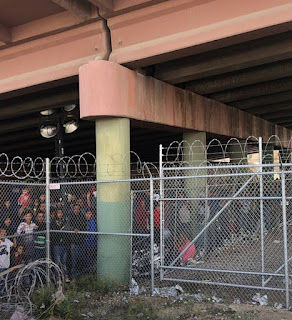Outrage grows over leaked government database targeting journalists, activists at US-Mexico border
by Kevin Martinez - WSWS
29 March 2019
According to leaked documents provided to local San Diego news station NBC 7, a government database has been targeting journalists and activists at the southern US border. As news has spread of the operation many other groups and organizations have also spoken of increased surveillance and harassment by the Border Patrol, ICE, and other government agencies for covering immigration in Mexico.
The database was part of Operation Secure Line, the Trump administration’s military operation to block immigrants who were travelling in last year’s Central American caravan. Images of the 59 persons targeted were included along with personal information and descriptive tags like “journalist” and “organizer” along with a large green “X” over some of the faces.
These markers would indicate that an alert had been placed on the person’s passport and if they were stopped would be forced into secondary inspection. Many activists and journalists would be detained for hours or had their passports held in limbo without being offered a credible explanation by the border authorities.
While many have long suspected that the government was tracking their whereabouts at the southern border, the documents obtained by NBC 7 prove the Trump administration is expanding its war on immigrants to attack the democratic rights of the entire population.
ACLU staff attorney Esha Bhandari told the Guardian, “I have not seen this kind of systematic targeting of journalists and advocates in this way,” adding, “I think it is very troubling, very disturbing.” Bhandari said,
“It means that the debate about immigrants’ rights, about the treatment of immigrants, about the treatment of asylum seekers, is going to be suppressed or censored because the people who are speaking out with a voice that’s critical of the government are going to be singled out for harsher treatment or punished.”
New York City activist Ravi Ragbir, director of the New Sanctuary Coalition, lived in the US for 23 years before he was arrested after a routine meeting with ICE. He was set to be deported to his native Trinidad before he was eventually released by a judge after public protests.
Ragbir told the media how his arrest was in retaliation for his campaign to free Gambian immigrant Baba Sillah, who also arrested after a routine check-in with ICE.
“It’s just very uncertain and very traumatizing to know the government is watching you,” Ravi told the Guardian.
“But I can’t allow that to debilitate me … If they’re going to move me, I might as well fight as hard as I can.”
Other groups pro-immigrant groups have also faced increasing surveillance by the state. Last October, three activist groups in Washington sued the government for retaliating against their members.
In November, the Vermont-based group Migrant Justice filed a lawsuit alleging the government had been spying on its members for years, including using an informant. One of the organizers, Will Lambek, told the Guardian how CBP detained and arrested at least 20 of its members between 2016 and 2018.
ICE Improvised Overpass Jail, El Paso
This month Nation magazine obtained a spreadsheet used by ICE to monitor protests planned in New York City, including the New Sanctuary Coalition. The revelation prompted the House Committee on Homeland Security to write a letter to the acting director of ICE to obtain more information about the spreadsheet.
The same committee, led by Democrat Bennie G. Thompson, sent a letter to CBP commissioner Kevin McAleenan expressing “great concern” about the agency’s spying. It stated,
the CBP’s “targeting (of) journalists, lawyers, and advocates… raises question about possible misuse of CBP’s border search authority and requires oversight to ensure the protection of Americans’ legal and constitutional rights.”
The panel’s Subcommittee on Border Security set a March 14 deadline for the CBP to provide a full list of individuals under surveillance, as well as “dossiers” on targeted individuals, a list of how many times they had been stopped by CBP, and other information. As of this writing, the CBP has failed to provide any of these documents.
In an effort at damage control, the CBP did release a statement saying the program was a necessary response to the so-called “assaults” on the border patrol in November of last year, when federal agents along with the US military fired tear gas at immigrants approaching the San Ysidro crossing on the Mexican border.
The CBP stated,
“efforts to gather this type of information are a standard law enforcement practice,” and said the agency, “does not target journalists for inspection based on their occupation or their reporting.”
An internal review had been started by the CBP’s Office of Professional Responsibility and the Office of Inspector General in the Department of Homeland Security to ostensibly check for any wrongdoing. However this had only been started after NBC 7 had contacted the government agencies on February 27.
Alex Mensing, an activist with Pueblo Sin Fronteras whose name appeared in the database, told NBC 7,
“What is especially concerning is the number of human rights defenders and journalists who are being interrogated and added to this list, which is only designed to intimidate them and discourage them from speaking out.”
He added, “It’s upsetting to know the U.S. government is using its resources to monitor human rights defenders and journalists who are doing their work.”
California Governor Gavin Newsom and local Democratic congressmen also criticized the program while the government of Mexico denied any involvement in the program. The foreign secretary said, “The Mexican government does not conduct illegal surveillance on anyone, for any type or category of activity.”


No comments:
Post a Comment